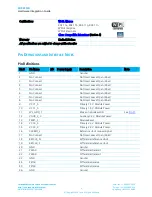
SDC-EC15N
Hardware Integration Guide
Embedded Wireless Solutions Support Center:
http://ews-support.lairdtech.com
www.lairdtech.com/bluetooth
13
© Copyright 2015 Laird. All Rights Reserved
Americas: +1-800-492-2320
Europe: +44-1628-858-940
Hong Kong: +852 2923 0600
interference will not occur in a particular installation. If this equipment does cause harmful
interference to radio or television reception, which can be determined by turning the equipment
off and on, the user is encouraged to try to correct the interference by one of the following
measures:
1.
Reorient or relocate the receiving antenna.
2.
Increase the separation between the equipment and receiver.
3.
Connect the equipment into an outlet on a circuit different from that to which the receiver
is connected.
4.
Consult the dealer or an experienced radio/TV technician for help.
FCC Caution: Any changes or modifications not expressly approved by the party responsible for
compliance could void the user's authority to operate this equipment.
This device complies with Part 15 of the FCC Rules. Operation is subject to the following two
conditions: (1) This device may not cause harmful interference, and (2) this device must accept any
interference received, including interference that may cause undesired operation.
IMPORTANT NOTE: FCC Radiation Exposure Statement:
This equipment complies with FCC radiation exposure limits set forth for an uncontrolled
environment. This equipment should be installed and operated with minimum distance 20cm
between the radiator & your body.
Industry Canada
User’s Guide Requirements
As outlined in the Operational Description, the SDC-EC15N complies with Industry Canada (IC) rules for a
Limited Modular Approval. To leverage Laird’s grant, the two conditions below must be met for the host
device into which the SDC-EC15N is integrated:
1.
The antenna is installed with 20 cm maintained between the antenna and users.
2.
The transmitter module is not co-located with any other transmitter or antenna that is capable of
simultaneous operation.
As long as the two conditions above are met, further
transmitter
testing is typically not required. However, the
OEM integrator is still responsible for testing its end-product for any additional compliance requirements
required with this module installed, such as (but not limited to) digital device emissions and PC peripheral
requirements.
Important! In the event that the two conditions above
cannot be met
(for example certain device
configurations or co-location with another transmitter), then the IC authorization is no longer
considered valid and the IC ID
cannot
be used on the final product. In these circumstances, the
OEM integrator will be responsible for re-evaluating the end product (including the transmitter)
and obtaining a separate IC authorization.



































